Thumplessness
Gary Cassara, one of our top clients, asked why CSM does not mention flexion and extension. He’s correct. We don’t use these words much. These words are misleading and cause trouble. Why is it that every time I’ve seen instructors talk about flexion and extension, their clients get screwed up?
In order to answer my buddy Gary – I’ll digress. A few years back I had a multiple email exchange with Horst Abraham, considered by many to be a god in PSIA. Our discourse boiled down to Horst telling me that skiing “can’t be taught; it can only be learned.” I mulled this over and finally got his point but with one reservation. What he said rang true for skiing but only after the stem habit was eliminated. He disagreed about the stem and unfortunately, our conversation ended. The stem is the natural instinctive defensive reaction that humans have to slipping and sliding. Millions of years ago when we were apes we did not like to slip. This remains true today. As skiers, our big-toe claw does not want to give up its grip on the surface until the other claw is engaged. Most grab the snow with one big-toe edge and don’t give it up until they engage the other one. Hint: Anytime the ski tips converge, there's a stem. In bumps, where the flaw can’t be hidden, most look like they’re on a wild pony after about 5 turns. In addition, the stem is defensive and ugly and prevents the most basic skill required for speed management.
 |
 |
When this habit continues well past puberty, even the best no longer have the stamina or strength to hop down bumps (air stems). Then, after too many thumps our experienced skier is relegated to groomers because “Bumps Hurt!” The stem or hop prevents the ski-snow contact essential for pressure control – the key to speed management. There is nothing about flexion and extension that’s ever going to help a stemmer. A stemmer's survival in the bumps depends on digging in with their claws to slow down.
When people become conscious of their stemming and learn the simple keys to eliminate it – they begin dancing with gravity. CSM’s primary goal is to eliminate the stem.
When focused on sensations in the feet with the goal of maintaining ski-snow contact, one will naturally flex and extend the right amount and at the right moment. The ability to respond to pressure “is something you cannot teach, it can only be learned.” I agree with Horst. A good coach accelerates learning by example and by finding the best terrain for directing focus to pressure sensations in the feet.
The good news is that once you own parallel turns, it’s easy to learn pressure management and ski ‘thumplessly’.
 |
|||||||||
| Fig 6 | Fig 5 | Fig 4 | Fig 3 | Fig 2 | Fig 1 | ||||
With a parallel turn and a conscious effort, one can immediately feel pressure build up in the feet. In Figs. 1-3, I’m flexing to relieve pressure as it ‘builds up’. This ‘feeling’ response to pressure prevents the dreaded ‘thump’ upfront. I’m not thinking, “flex here” – I’m simply feeling pressure and relieving it. Conversely in Figs. 4-6, I’m extending to maintain resistance, feel, and pressure against the snow. This constant contact prevents the ‘thump’ on the backend of the bump. This down and up movement is the body's natural response to control pressure sensations in the feet. Mileage and the good eyes of a coach allow our clients to take on more speed while ‘learning’ the ultimate skill of thumplessness! Leave the thumps to the kids and those that have not learned; we’re only allotted so many thumps in one lifetime.
“It can only be learned, it can not be taught.” Horst is correct (once the stem is eliminated)!
Leave a Comment
You must be logged in to post a comment.







John, thank you for putting so much thought and effort in helping me clear things up. I do understand “the feeling” of pressure building underfoot. This makes perfect sense. They key for me and many is to learn to recognize that sensation and how to respond accordingly. I know this comes through the watchful eye of a great coach and repetition.
Generally the pressure underfoot is greatest in the bottom of the turn and less in the top of the turn. Therefore flexing at the end of the turn relieves pressure and coincidentally also gives one the opportunity to extend into the new turn thus increasing the pressure in the top of the turn. This type flexion extension helps to even out the pressure in a turn and avoid the balance disruptions of sudden and heavy pressure. However this cannot be all a complete skier knows or feels. I agree with John that flexion and extension are in response to the pressures felt or anticipated. Moguls, snow conditions and countless other situations prevent one from saying with certainty that you always flex here and extend there.